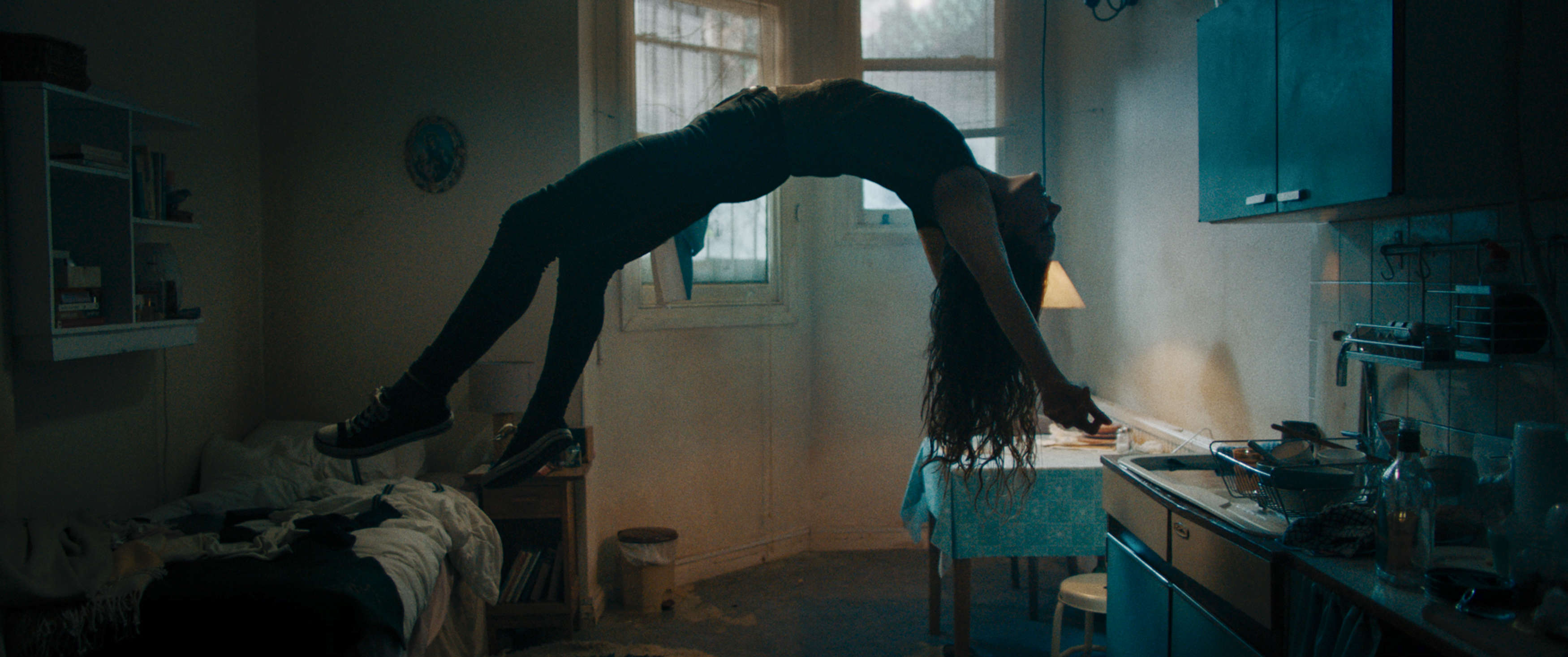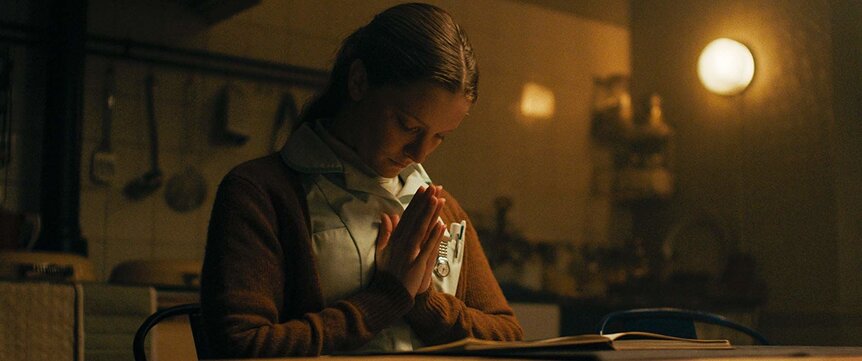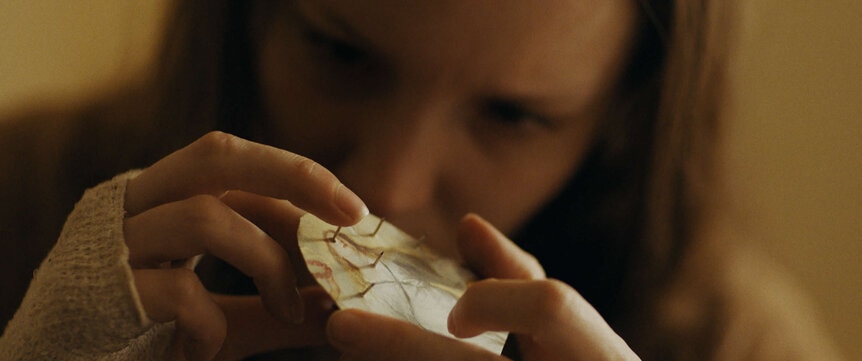Create a free profile to get unlimited access to exclusive videos, sweepstakes, and more!
Rose Glass reveals the real-life religious and BDSM inspirations behind the horror of 'Saint Maud'

The Exorcist. Rosemary's Baby. Saint Maud. In a bold marketing move, the production company behind Saint Maud, A24, created a screening series that paired two of the most iconic religious horror movies in cinema history to the theatrical premiere of an eerie offering out of the U.K. As writer/director Rose Glass' feature debut, Saint Maud seemed destined to earn its place beside the William Friedkin and Roman Polanski classics. The frightening film earned rave reviews on the festival circuit and was gearing up for a fresh wave of critical praise as it readied for its March 2020 bow. Then, the pandemic hit.
With movie theaters shuttering around the world, the future of Saint Maud was uncertain. Its debut was quietly postponed as A24 and the world awaited word on what was to become of the cinema scene of 2020. Now, Saint Maud is poised to hit theaters on Jan. 29 — nearly 10 months after it was originally supposed to premiere. However, during its time of uncertainty, we spoke with Glass via phone because we couldn't wait to speak to her about one of our favorite new horror films of the year.
Saint Maud stars Morfydd Clark as the eponymous nurse, a mousy young Catholic who dedicates herself not only to caring for the sick but also to saving their souls. When Maud is assigned the home-care of a dying choreographer named Amanda (Jennifer Ehle), she is fascinated by her sophistication and talent, but shocked by her decadence and sexual thirsts. Believing herself to be on a mission from God — with whom she speaks daily — Maud hopes to rescue Amanda by introducing her to the Almighty's love, which for the young nurse expresses itself in ways ghoulish and orgasmic (literally). But when this love is rejected, Maud's mad zealotry leads her down a dark path of self-flagellation, delusion, and carnage.
After making a string of short films and graduating from National Film and Television School, Glass began to develop the premise for what would be her first feature. "It's hard to pinpoint [its inspiration] because it's an amalgamation of lots of weird stuff that I'm interested in that was floating around my head," Glass explains. "But I knew I wanted to do a film, which was very subjective and totally set inside somebody's head as they were going through some kind of break with reality.
"I think at the time I'd been reading about people who hear voices in their heads," she continues. "Depending on various conditions or things that could lead to that, there's different roles it can play in people's lives. And that just struck me as an interesting premise or device for a film to have the central relationship be between the main character and somebody in their head, or somebody who the rest of the world can't see. So that was where it started and then developed from there."
To tell the story of Maud, Glass realized there were two very different perspectives the film must present. "There are two parallel narratives working throughout the whole film," Glass says. "Like the 'real narrative' is that a young, traumatized woman goes to work for a retired dancer. She has struggling mental health, doesn't get the support she needs, bad things happen. But obviously, that's very much not how Maud sees it. She's on this holy mission and she'd got to save this woman's soul."
In her film, Glass extends an earnest empathy to Maud by ushering audiences into the anti-heroine's perspective. "The last thing I wanted to make was a small, bleak, depressing naturalistic film," Glass says. "I kept telling people that visually and aesthetically, everything has to be incredibly heightened and sensual and visceral and really put the audience in a front-row seat in her head and have the whole thing feel like a bit of an emotional roller coaster. And, yeah, a lot of the stuff that happens is quite bleak, but she thinks that what she's doing is incredibly important and very exciting and has Biblical levels of grandiose delusions."
As she adds, "I wanted people to understand why she does what she does."
To achieve this, Glass' script follows Maud through eavesdropping on Amanda's sexual encounters, orgasmic visits from the spirit of God, and terrifying visions that reveal His disappointment when she falters in her mission. Glass also shows private moments of penance, in which Maud willingly hurts herself to offer up her suffering to the Lord. For these bits, this fascinating filmmaker pulled inspiration from real religious practices and the BDSM fetish community.
An early scene of such painful penance shows Maud kneeling on hard kernels of popcorn as she prays. "I have friends who grew up in South America," she explains. "And they said that their grandma would maybe get them to do that or something similar as punishment." In another cringe-inducing sequence of body horror, Maud goes for a walk wearing sole inserts she studded with foot-facing thumbtacks, her shoes squishing with blood on every step. This came from the kinky side of the internet. "There was this forum where people were putting up suggestions for little tricks and things that you could do to make your experience that bit more painful," Glass says of the BDSM website she explored. "Somebody drew a little diagram similar to what we've got in the film. I think they used gaffer tape instead of cardboard, then [put] pins in someone's shoes. I saw that several years ago and was just like, 'Bloody hell.' I guess it stuck in my head."
To make these moments of pain and religious passion a visceral experience for theatergoers, Glass turned to her director of photography Ben Fordesman and sound designer Paul Davies. With Fordesman, she plotted a plan for cinematography that would visually mirror Maud's deteriorating mind. "We tried to make it so that as her mental state unravels throughout the film, the visual language of the film does the same and gets a bit looser and more exaggerated," Glass explains. "So, in the beginning, generally the shots are a lot more controlled and formal. Then, toward the end, we get more topsy-turvy."
As to the sound design, Glass had an ace in her pocket with Davies, the celebrated designer of the soundscapes of Lynne Ramsay's haunting psychological thrillers You Were Never Really Here and We Need To Talk About Kevin. Glass had an in with him, as he was her teacher during her MA program. "[Davies] was the first person I asked to come on board, he was like, 'Yes, of course.' He's phenomenal," Glass gushes, adding that while the cinematography begins in a formal space, Saint Maud's sound design is surreal and ominous from the start. The scratching of metal, a weird watery echoing, and eerie groans throb throughout the film to envelop audiences in the emotional chaos of its protagonist. "With Paul and the sound design, I just said pretty much from the get-go we can be super heightened, super subjective, like picking out lots of really heightened visceral little details of sounds that she can hear," Glass says. "Again just to put you right in her head."
Abruptly, the excitement leaves Glass' voice. "It's weird seeing it from a different screen, like how much sound varies from screen to screen," Glass laments, "which is sometimes a little frustrating because there's a lot of very detailed subtle bits going on in the mix that sometimes get lost in that it's just very quiet." She worries what will be lost of Saint Maud if audiences first see her film on their home televisions as opposed to in a movie theater with a top-notch sound system.
As someone who has seen the film both ways, I told Glass that Saint Maud is sensational either way. However, I definitely missed the sensation of being swallowed by the darkness of the theater and the intensity of Davies' sound design when I was rewatching at home. So, I asked her for the advice she'd offer audiences who will see the movie at home instead of in the cinemas. How should they watch it?
"Loud," she answers. "Or with headphones, at least. When you watch any film, if you can, try and play it loud. You'll just enjoy it more."
Saint Maud opens in theaters on Jan. 29 and comes to Epix on Feb. 12.
















